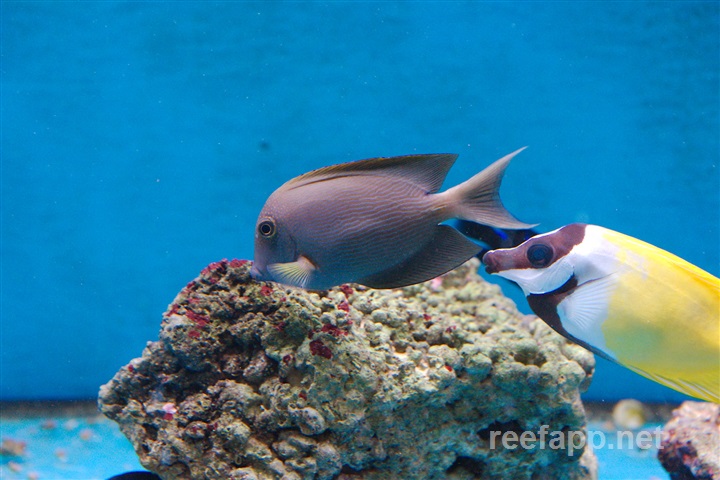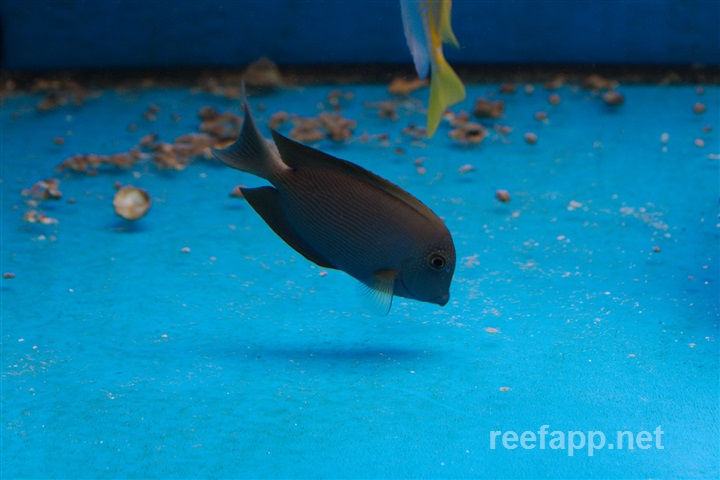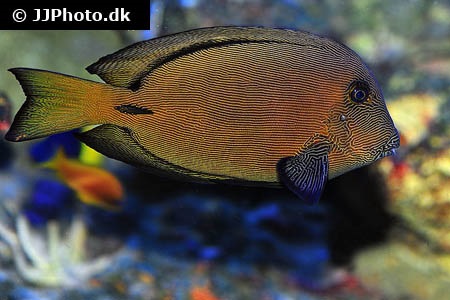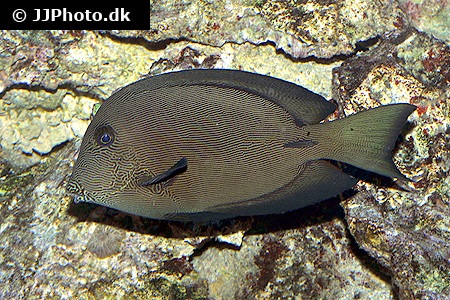Ctenochaetus striatus




| Latin name | Ctenochaetus striatus - (Quoy & Gaimard, 1825) |
|---|---|
| Local name | Orange Stripe Bristletooth Tang |
| Family | Acanthuridae - Ctenochaetus |
| Origin | East Indian Ocean, West Indian Ocean, Australia, Japan, The Red Sea, Indonesia |
| Max length | 26 cm (10.2") |
| Minimum volume |
500 l (132 gal) |
|---|---|
| Hardiness |
Average |
| Suitable for aquarium |
Suitable with care |
| Reef safe |
Always reef safe |
| Aggressiveness | Mostly peaceful but might be aggressive towards similar species |
| Recommended |
Macroalgea (Eg. seaweed / nori) Microalgea (Eg. spirulina) |
|---|---|
| Mostly |
Detritus Small crustaceans (Krill, mysis, artemia...) |
These fish should be kept in a well run aquarium where they can "graze" algae from rocks and stones.
If there are insufficient algae on the rocks, it is important to feed more frequently and supplement with algae rich food e.g. Spirulina.
This species revels in swimming and requires an aquarium with ample space.
This species requires places to hide, especially when newly introduced into the aquarium.
Even though these fish enjoy a diverse type of frozen foods, it is imperative that its primary food, is algae based, thus ensuring that the fish`s immune system remains healthy.
This can, for example, be plant based fish flakes, Nori seaweed or similar.
Their colour becomes darker when adult. It can vary a little depending on where the fish originates.
The genus Bristletooth Tang (Ctenochaetus) contains a range of species, which are characterized by special teeth.
Like other Surgeonfish the Bristletooth Tang eats algae but with their specialized teeth they also scrape other organic material from rocks and stones. Ample sand and rocks are therefore imperative.
Overall the Ctenochaetus are peaceful and not quite as active, as many of the other surgeonfish. It is therefore suited to smaller aquaria.
Because of these their mild behaviour they are not a good combination with some of the more aggressive Surgeonfish.
Ctenochaetus are not so colourful as many other Surgeonfish. Some species are more vibrant in colour but this changes when they get to around 3 inch (7-8 cm).
Surgeonfish (Acanthuridae) live primarily of different types of algae, making it a popular choice for coral aquariums, as they help to keep the aquarium algae free.
Most Surgeonfish have a scalpel by the caudal fin, used to defend themselves. It can cause some deep lacerations, so pay attention if the fish start to fight and when handling the fish.
When in the aquarium, they will spend most of their time swimming around and nibbling the algae from the stones. Surgeonfish will rarely irritate corals or invertebrates. Large Palettes/Blue tangs can be an exception.
The Surgeonfish are not typically aggressive towards other types of fish. If more Surgeonfish are added to the aquarium, they will establish a hierarchy. It is best to add the most aggressive species last and to ensure that there are sufficient hiding places, as they prefer to have their own individual sleeping area.
If multiple aggressive species are added to the same aquarium, one runs the risk of one of them dying due to stress. One must therefore be cautious about adding multiple Acanthurus species or Zebrasoma xanthurum into the same aquarium. A combination of the different genera will normally get along well, although the more aggressive species can still be challenging.
| Aquarium trade | Yes |
|---|---|
| Distribution | Indo-Pacific: throughout the region excluding the Hawaiian, Marquesas and Easter islands. Record from Baker Island (US Minor Islands) based on a photograph (Ref. 42056). Absent from Malden and Jarvis islands (Ref. 1602). |
| English common names |
Surgeonfish Striated surgeonfish Striped bristletooth Striped bristle-tooth Lined bristletooth Orange-dotted bristletooth |
| Danish common names |
Stribet kirurgfisk |
| German common names |
Gestreifter Borstenzahn-Doktorfisch |
| French common names |
Chirurgien strié Chirurgien noir |
Henry C. Schultz. 2003. Is it a Comb or a Bristle (Surgeonfish)? The Genus Ctenochaetus - Reefkeeping Magazine - (English)
Bob Fenner. The "Bristle-Tooth" Surgeonfishes, Genus Ctenochaetus - Wet Web Media - (English)
James W. Fatherree. 2009. Aquarium Fish: Surgeonfishes, A.K.A. the Tangs - Advanced Aquarist - (English)
Bob Fenner. Surgeons, Tangs and Doctorfishes, Family Acanthuridae - Wet Web Media - (English)
2013. Kirurgfisk - Saltvandswiki - (Danish)

